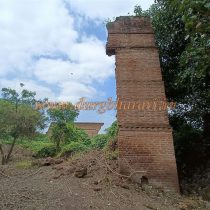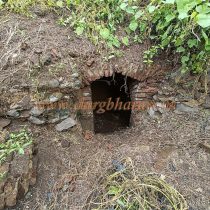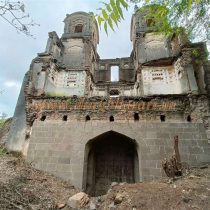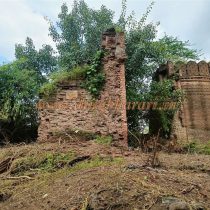KATHAPUR
TYPE : FORTRESS / CITY FORT
DISTRICT : PUNE
HEIGHT : 0
Ambegaon taluka of Pune district is known as the taluka of prosperous farmers as it is the leader in terms of agricultural income due to the presence of water of Ghodnadi. But we are familiar with this taluka because of its stronghold fortress. One such neglected fort full of architectural remains can be found in Kathapur (Budruk) village on the bank of river Ghodnadi. Kathapur (Budruk) village is 70 km from Pune city and 30 km from Manchar city. Before going to the village, from the Ghodnadi Bridge, the spacious ramparts of the fort and the door attract our attention. After that, looking at the huge wall while entering the village, it is felt that sometime the village had been inside the ramparts. This door is built in stone and is 20 feet high and there are carved idols on both sides of the door. Although the arches of this door have fallen to some extent, the wooden doors still remain.
...
This main door has a small passage door and inside the door there are guard’s room on both sides. As the villagers know this fort as “Rajwada/Vaghacha Wada”, we easily reach this fort. There is a large number of thorn bushes in the vicinity of the fort and one has to reach the gate of the fort by walking through it. This square-shaped fort is spread over about half an acre and there are four round-shaped bastions at the four ends of the fort. The bastion here has given it a unique beauty. The 10 feet high rampart at the bottom of the fort is built of stone and the structure above it is made of bricks. This rampart is about 25-30 feet high. In this construction, there are holes for firing guns as well as holes for cannons are visible. The gate of the fort faces north and its wooden doors are still in good condition. One third of the door is made of stone, and the two parts are made of brick and plastered with lime. Two dome-shaped umbrellas in Rajasthani style are erected here. Due to the accumulation of soil on the inner side of the gate, it cannot be opened, so one has to enter the fort through the ruined ramparts adjacent to the gate. After entering the fort, one can see the huge growth of thorn bushes. You have to see the ruins of the fort while walking through this. In the center of the fort is a spacious porch of the wada (old mansion), most of which has been buried by the fall from above. A dry well can be seen in the back of the porch. The ramparts walls are still in decent condition. 15 minutes are enough to see the fort as the inner part of the fort is completely destroyed. There is a memorial in the fort premises and a well in the river bed adjacent to the ramparts on the left side of the fort. At some distance from the fort, there are three Peshwa-era temples with carvings. It is read that two cannons in this fort were placed in front of the school in the village, but at present only one cannon can be seen there. Apart from this, the well built along with this fort can be seen outside the village as a water facility for the village. This well is now a private property of the Karande family. Santaji Haibatrao Wagh was an important part in Sardar Malharrao Holkar's army. Mahindpur in Malwa was of the Holkar’s under their control. The responsibility of this place was handled very well by the Wagh family. The local people knew these chieftains as “Wagh Raja”. Due to the bravery of Santaji Haibatrao Wagh, he was awarded some land in Kathapur and he built this fort here. Santaji Wagh was martyred in the battle of Panipat in 1761. In the year 1765, the descendants of Santaji Wagh were given the Jagiri of Mahindpur and some other villages in Madhya Pradesh as well as the villages of Kathapur (Budruk), Kathapur (Khurd), and Awasari (Budruk) in Maharashtra from the Holkar’s. Santaji Wagh's daughter Pritabai was married to Subhedar Malerao Holkar. Therefore, Wagh was in a way Holkar's scourge. Currently this fort has been bought by Nandkumar Kale and he is thinking of starting historical and environmental tourism here while maintaining the original fort.
© Suresh Nimbalkar


























